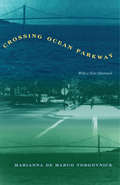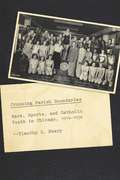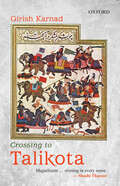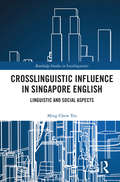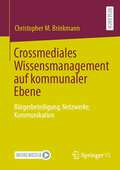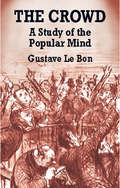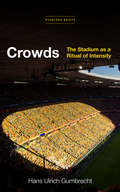- Table View
- List View
Crossing Ocean Parkway
by Marianna De TorgovnickGrowing up an Italian-American in the Bensonhurst neighborhood of New York city, Marianna De Marco longed for college, culture, and upward mobility. Her daydreams circled around WASP (White Anglo Saxon Protestant) heroes on television—like Robin Hood and the Cartwright family—but in Brooklyn she never encountered any. So she associated moving up with Ocean Parkway, a street that divides the working-class Italian neighborhood where she was born from the middle-class Jewish neighborhood into which she married. This book is Torgovnick's unflinching account of crossing cultural boundaries in American life, of what it means to be an Italian American woman who became a scholar and literary critic. Included are autobiographical moments interwoven with engrossing interpretations of American cultural icons from Dr. Dolittle to Lionel Trilling, The Godfather to Camille Paglia. Her experiences allow her to probe the cultural tensions in America caused by competing ideas of individuality and community, upward mobility and ethnic loyalty, acquisitiveness and spirituality.
Crossing Parish Boundaries: Race, Sports, and Catholic Youth in Chicago, 1914-1954 (Historical Studies of Urban America)
by Timothy B. NearyControversy erupted in spring 2001 when Chicago’s mostly white Southside Catholic Conference youth sports league rejected the application of the predominantly black St. Sabina grade school. Fifty years after Brown v. Board of Education, interracialism seemed stubbornly unattainable, and the national spotlight once again turned to the history of racial conflict in Catholic parishes. It’s widely understood that midcentury, working class, white ethnic Catholics were among the most virulent racists, but, as Crossing Parish Boundaries shows, that’s not the whole story. In this book, Timothy B. Neary reveals the history of Bishop Bernard Sheil’s Catholic Youth Organization (CYO), which brought together thousands of young people of all races and religions from Chicago’s racially segregated neighborhoods to take part in sports and educational programming. Tens of thousands of boys and girls participated in basketball, track and field, and the most popular sport of all, boxing, which regularly filled Chicago Stadium with roaring crowds. The history of Bishop Sheil and the CYO shows a cosmopolitan version of American Catholicism, one that is usually overshadowed by accounts of white ethnic Catholics aggressively resisting the racial integration of their working-class neighborhoods. By telling the story of Catholic-sponsored interracial cooperation within Chicago, Crossing Parish Boundaries complicates our understanding of northern urban race relations in the mid-twentieth century.
Crossing Parish Boundaries: Race, Sports, and Catholic Youth in Chicago, 1914-1954 (Historical Studies of Urban America)
by Timothy B. NearyControversy erupted in spring 2001 when Chicago’s mostly white Southside Catholic Conference youth sports league rejected the application of the predominantly black St. Sabina grade school. Fifty years after Brown v. Board of Education, interracialism seemed stubbornly unattainable, and the national spotlight once again turned to the history of racial conflict in Catholic parishes. It’s widely understood that midcentury, working class, white ethnic Catholics were among the most virulent racists, but, as Crossing Parish Boundaries shows, that’s not the whole story. In this book, Timothy B. Neary reveals the history of Bishop Bernard Sheil’s Catholic Youth Organization (CYO), which brought together thousands of young people of all races and religions from Chicago’s racially segregated neighborhoods to take part in sports and educational programming. Tens of thousands of boys and girls participated in basketball, track and field, and the most popular sport of all, boxing, which regularly filled Chicago Stadium with roaring crowds. The history of Bishop Sheil and the CYO shows a cosmopolitan version of American Catholicism, one that is usually overshadowed by accounts of white ethnic Catholics aggressively resisting the racial integration of their working-class neighborhoods. By telling the story of Catholic-sponsored interracial cooperation within Chicago, Crossing Parish Boundaries complicates our understanding of northern urban race relations in the mid-twentieth century.
Crossing Parish Boundaries: Race, Sports, and Catholic Youth in Chicago, 1914-1954 (Historical Studies of Urban America)
by Timothy B. NearyControversy erupted in spring 2001 when Chicago’s mostly white Southside Catholic Conference youth sports league rejected the application of the predominantly black St. Sabina grade school. Fifty years after Brown v. Board of Education, interracialism seemed stubbornly unattainable, and the national spotlight once again turned to the history of racial conflict in Catholic parishes. It’s widely understood that midcentury, working class, white ethnic Catholics were among the most virulent racists, but, as Crossing Parish Boundaries shows, that’s not the whole story. In this book, Timothy B. Neary reveals the history of Bishop Bernard Sheil’s Catholic Youth Organization (CYO), which brought together thousands of young people of all races and religions from Chicago’s racially segregated neighborhoods to take part in sports and educational programming. Tens of thousands of boys and girls participated in basketball, track and field, and the most popular sport of all, boxing, which regularly filled Chicago Stadium with roaring crowds. The history of Bishop Sheil and the CYO shows a cosmopolitan version of American Catholicism, one that is usually overshadowed by accounts of white ethnic Catholics aggressively resisting the racial integration of their working-class neighborhoods. By telling the story of Catholic-sponsored interracial cooperation within Chicago, Crossing Parish Boundaries complicates our understanding of northern urban race relations in the mid-twentieth century.
Crossing Parish Boundaries: Race, Sports, and Catholic Youth in Chicago, 1914-1954 (Historical Studies of Urban America)
by Timothy B. NearyControversy erupted in spring 2001 when Chicago’s mostly white Southside Catholic Conference youth sports league rejected the application of the predominantly black St. Sabina grade school. Fifty years after Brown v. Board of Education, interracialism seemed stubbornly unattainable, and the national spotlight once again turned to the history of racial conflict in Catholic parishes. It’s widely understood that midcentury, working class, white ethnic Catholics were among the most virulent racists, but, as Crossing Parish Boundaries shows, that’s not the whole story. In this book, Timothy B. Neary reveals the history of Bishop Bernard Sheil’s Catholic Youth Organization (CYO), which brought together thousands of young people of all races and religions from Chicago’s racially segregated neighborhoods to take part in sports and educational programming. Tens of thousands of boys and girls participated in basketball, track and field, and the most popular sport of all, boxing, which regularly filled Chicago Stadium with roaring crowds. The history of Bishop Sheil and the CYO shows a cosmopolitan version of American Catholicism, one that is usually overshadowed by accounts of white ethnic Catholics aggressively resisting the racial integration of their working-class neighborhoods. By telling the story of Catholic-sponsored interracial cooperation within Chicago, Crossing Parish Boundaries complicates our understanding of northern urban race relations in the mid-twentieth century.
Crossing Parish Boundaries: Race, Sports, and Catholic Youth in Chicago, 1914-1954 (Historical Studies of Urban America)
by Timothy B. NearyControversy erupted in spring 2001 when Chicago’s mostly white Southside Catholic Conference youth sports league rejected the application of the predominantly black St. Sabina grade school. Fifty years after Brown v. Board of Education, interracialism seemed stubbornly unattainable, and the national spotlight once again turned to the history of racial conflict in Catholic parishes. It’s widely understood that midcentury, working class, white ethnic Catholics were among the most virulent racists, but, as Crossing Parish Boundaries shows, that’s not the whole story. In this book, Timothy B. Neary reveals the history of Bishop Bernard Sheil’s Catholic Youth Organization (CYO), which brought together thousands of young people of all races and religions from Chicago’s racially segregated neighborhoods to take part in sports and educational programming. Tens of thousands of boys and girls participated in basketball, track and field, and the most popular sport of all, boxing, which regularly filled Chicago Stadium with roaring crowds. The history of Bishop Sheil and the CYO shows a cosmopolitan version of American Catholicism, one that is usually overshadowed by accounts of white ethnic Catholics aggressively resisting the racial integration of their working-class neighborhoods. By telling the story of Catholic-sponsored interracial cooperation within Chicago, Crossing Parish Boundaries complicates our understanding of northern urban race relations in the mid-twentieth century.
Crossing Parish Boundaries: Race, Sports, and Catholic Youth in Chicago, 1914-1954 (Historical Studies of Urban America)
by Timothy B. NearyControversy erupted in spring 2001 when Chicago’s mostly white Southside Catholic Conference youth sports league rejected the application of the predominantly black St. Sabina grade school. Fifty years after Brown v. Board of Education, interracialism seemed stubbornly unattainable, and the national spotlight once again turned to the history of racial conflict in Catholic parishes. It’s widely understood that midcentury, working class, white ethnic Catholics were among the most virulent racists, but, as Crossing Parish Boundaries shows, that’s not the whole story. In this book, Timothy B. Neary reveals the history of Bishop Bernard Sheil’s Catholic Youth Organization (CYO), which brought together thousands of young people of all races and religions from Chicago’s racially segregated neighborhoods to take part in sports and educational programming. Tens of thousands of boys and girls participated in basketball, track and field, and the most popular sport of all, boxing, which regularly filled Chicago Stadium with roaring crowds. The history of Bishop Sheil and the CYO shows a cosmopolitan version of American Catholicism, one that is usually overshadowed by accounts of white ethnic Catholics aggressively resisting the racial integration of their working-class neighborhoods. By telling the story of Catholic-sponsored interracial cooperation within Chicago, Crossing Parish Boundaries complicates our understanding of northern urban race relations in the mid-twentieth century.
Crossing Sex and Gender in Latin America
by V. LewisSignifying "others" or signs of life? This book critically examines the ways in which crossing sex and gender is imagined in key cultural texts from contemporary Latin America. Unlike previous studies, Crossing Sex and Gender in Latin America does not hold that sexually diverse figures are always and only performative or allegorical and instead places the accent on questions of the presence or absence of an account of subjectivity in contemporary representation. Via analysis of selected films and literary works of Reinaldo Arenas, Mayra Santos-Febres, Pedro Lemebel, among others, the author reflects on the political implications of recent visions (1985-2005).
Crossing the Ethnic Divide: The Multiethnic Church on a Mission (AAR Academy Series)
by Kathleen Garces-FoleyWhile religious communities often stress the universal nature of their beliefs, it remains true that people choose to worship alongside those they identify with most easily. Multiethnic churches are rare in the United States, but as American attitudes toward diversity change, so too does the appeal of a church that offers diversity. Joining such a community, however, is uncomfortable-worshippers must literally cross the barriers of ethnic difference by entering the religious space of the ethnically "other." Through the story of one multiethnic congregation in Southern California, Kathleen Garces-Foley examines what it means to confront the challenges in forming a religious community across ethnic divisions and attracting a more varied membership.
Crossing the Ethnic Divide: The Multiethnic Church on a Mission (AAR Academy Series)
by Kathleen Garces-FoleyWhile religious communities often stress the universal nature of their beliefs, it remains true that people choose to worship alongside those they identify with most easily. Multiethnic churches are rare in the United States, but as American attitudes toward diversity change, so too does the appeal of a church that offers diversity. Joining such a community, however, is uncomfortable-worshippers must literally cross the barriers of ethnic difference by entering the religious space of the ethnically "other." Through the story of one multiethnic congregation in Southern California, Kathleen Garces-Foley examines what it means to confront the challenges in forming a religious community across ethnic divisions and attracting a more varied membership.
Crossing the Psycho-Social Divide: Freud, Weber, Adorno and Elias
by George CavallettoThe prevailing view among social scientists is that the psyche and the social reside in such disparate domains that their proper study demands markedly incompatible analytical and theoretical approaches. Over the last decade, scholars have begun to challenge this view. In this innovative work, George Cavalletto moves this challenge forward by connecting it to theoretical and analytical practices of the early 20th century. His analysis of key texts by Sigmund Freud, Max Weber, Theodor Adorno and Norbert Elias shows that they crossed the psycho-social divide in ways that can help contemporary scholars to re-establish an analytical and theoretical understanding of the inherent interconnection of these two domains. This book will particularly interest scholars and students in sociology and social psychology, especially those in the fields of social theory, the sociology of emotion, self and society, and historical sociology.
Crossing the Psycho-Social Divide: Freud, Weber, Adorno and Elias
by George CavallettoThe prevailing view among social scientists is that the psyche and the social reside in such disparate domains that their proper study demands markedly incompatible analytical and theoretical approaches. Over the last decade, scholars have begun to challenge this view. In this innovative work, George Cavalletto moves this challenge forward by connecting it to theoretical and analytical practices of the early 20th century. His analysis of key texts by Sigmund Freud, Max Weber, Theodor Adorno and Norbert Elias shows that they crossed the psycho-social divide in ways that can help contemporary scholars to re-establish an analytical and theoretical understanding of the inherent interconnection of these two domains. This book will particularly interest scholars and students in sociology and social psychology, especially those in the fields of social theory, the sociology of emotion, self and society, and historical sociology.
Crossing to Talikota
by Girish KarnadThe year is 1565. Devastation reigns over the once-renowned Vijayanagara Empire. Its powerful army has buckled under the assault of four minor Sultanates. Within a few hours of the Battle of Talikota, the political contours of southern India have been radically altered, the rich and prosperous capital city, Vijayanagara, plundered, decimated, and abandoned. It would lie uninhabited for centuries, known thereafter only as ‘the ruins of Hampi’. Behind this cataclysm swirls a saga of ruthless ambition, caste, and religious conflict, family intrigue and betrayal, driven by the power hungry ‘Aliya’ Ramaraya, son-in-law of the emperor Krishna Deva Raya. A brilliant strategist and diplomat, he ruled the empire with an iron hand but was unacceptable to his own people as the legitimate heir because he lacked royal blood. In Crossing to Talikota, Girish Karnad focuses on the interplay of characters who have been ignored by history even though they played integral roles in shaping one of its darkest chapters.
Crosslinguistic Influence in Singapore English: Linguistic and Social Aspects (Routledge Studies in Sociolinguistics)
by Ming Chew TeoIn a social setting where speakers with several languages interact extensively, a major source of variation in Colloquial Singapore English comes from the complex interaction between crosslinguistic influences and various social and linguistic factors. By unifying both social and linguistic aspects of the phenomenon through the use of multivariate analyses like logistic regressions and Poisson regressions, this book represents a novel approach to the study of crosslinguistic influence in Colloquial Singapore English. As multivariate analyses provide us with information regarding the relative strengths of each social and linguistic factor, they are useful tools that allow us to have a more nuanced understanding of crosslinguistic influence in contact situations. Linguistic features from a variety of linguistic domains – morphology, semantics, and discourse – will be quantified, and statistical analyses will be run in R to determine the degree to which various social and linguistic factors affect the extent of crosslinguistic influence. Well-known Singlish features like the optionality of past tense and plural marking, the unique meanings of already, got, and one, and discourse particles lah, leh, and lor, are analyzed using this approach. The statistical modeling of these features is a first step towards creating a unified framework to understanding crosslinguistic influence.
Crosslinguistic Influence in Singapore English: Linguistic and Social Aspects (Routledge Studies in Sociolinguistics)
by Ming Chew TeoIn a social setting where speakers with several languages interact extensively, a major source of variation in Colloquial Singapore English comes from the complex interaction between crosslinguistic influences and various social and linguistic factors. By unifying both social and linguistic aspects of the phenomenon through the use of multivariate analyses like logistic regressions and Poisson regressions, this book represents a novel approach to the study of crosslinguistic influence in Colloquial Singapore English. As multivariate analyses provide us with information regarding the relative strengths of each social and linguistic factor, they are useful tools that allow us to have a more nuanced understanding of crosslinguistic influence in contact situations. Linguistic features from a variety of linguistic domains – morphology, semantics, and discourse – will be quantified, and statistical analyses will be run in R to determine the degree to which various social and linguistic factors affect the extent of crosslinguistic influence. Well-known Singlish features like the optionality of past tense and plural marking, the unique meanings of already, got, and one, and discourse particles lah, leh, and lor, are analyzed using this approach. The statistical modeling of these features is a first step towards creating a unified framework to understanding crosslinguistic influence.
Crossmediales Wissensmanagement auf kommunaler Ebene: Bürgerbeteiligung, Netzwerke, Kommunikation
by Christopher M. BrinkmannIn diesem Buch werden die Bürgerbeteiligung auf kommunaler Ebene und das Wissen, das über Kommunikation in den Netzwerken der Akteure der politischen Partizipation und des zivilgesellschaftlichen Engagements tradiert wird, aus medien- und kommunikationswissenschaftlicher Sicht betrachtet. Der Fokus der Untersuchung liegt auf dialogorientiert-informellen Verfahren und dem medienübergreifenden Abrufen, Akkumulieren, Generieren und Ausbilden von Wissen in der Bürgerbeteiligung über ein crossmediales Wissensmanagement. Aus der Zusammenführung normativ-theoretischer Überlegungen und der empirischen Befunde einer Feldforschung im Raum Mittweida wird das Konzept der wissensorientierten Bürgerkommune entwickelt. Dafür werden fünf Bausteine vorgeschlagen, die bei der Etablierung von dialogorientiert-informeller Bürgerbeteiligung sowie einem crossmedialen Wissensmanagement auf kommunaler Ebene helfen können. Die normativ-theoretischen Überlegungen, die empirischen Befunde und auch die Konzeptentwicklung sind sowohl für den wissenschaftlichen Diskurs um die Förderung von Bürgerbeteiligung als auch für Praktiker der Zivilgesellschaft und der politisch-administrativen Ebene in Kommunen relevant.
Crossover Stars in the Hindi Film Industry: Globalizing Pakistani Identity
by Dina KhdairThis book explores the cultural politics of Pakistani crossover stardom in the Hindi film industry as a process of both assimilation and “Otherness”. Analysing the career profiles of three crossover performers – Ali Zafar, Fawad Khan, and Mahira Khan – as a relevant case study, it unites critical globalization studies with soft power theory in exploring the potential of popular culture in conflict resolution. The book studies the representation and reception of these celebrities, while discussing themes such as the meaning of being a Pakistani star in India, and the consequent identity politics that come into play. As the first comprehensive study of Pakistani crossover stardom, it captures intersections between political economy, cultural representation, and nationalist discourse, at the same time reflecting on larger questions of identity and belonging in an age of globalization. Crossover Stars in the Hindi Film Industry will be indispensable to researchers of film studies, media and cultural studies, popular culture and performance, peace and area studies, and South Asian studies. It will also be of interest to enthusiasts of Indian cinematic history.
Crossover Stars in the Hindi Film Industry: Globalizing Pakistani Identity
by Dina KhdairThis book explores the cultural politics of Pakistani crossover stardom in the Hindi film industry as a process of both assimilation and “Otherness”. Analysing the career profiles of three crossover performers – Ali Zafar, Fawad Khan, and Mahira Khan – as a relevant case study, it unites critical globalization studies with soft power theory in exploring the potential of popular culture in conflict resolution. The book studies the representation and reception of these celebrities, while discussing themes such as the meaning of being a Pakistani star in India, and the consequent identity politics that come into play. As the first comprehensive study of Pakistani crossover stardom, it captures intersections between political economy, cultural representation, and nationalist discourse, at the same time reflecting on larger questions of identity and belonging in an age of globalization. Crossover Stars in the Hindi Film Industry will be indispensable to researchers of film studies, media and cultural studies, popular culture and performance, peace and area studies, and South Asian studies. It will also be of interest to enthusiasts of Indian cinematic history.
Crossroads of Rural Crime: Representations and Realities of Transgression in the Australian Countryside
by Alistair HarknessRural-oriented scholarship in criminology is growing, in part motivated by governmental, community and academic recognition that, despite stereotypes of the 'rural idyll', crime and justice are significant issues in the rural landscape. Using the notion of 'crossroads' to provide a unique lens through which to examine realities of rural crime, Crossroads of Rural Crime: Representations and Realities of Transgression in the Australian Countryside provides a dynamic understanding of the nature of rural life and ways in which transgression manifests itself in the context of a presumed rural-urban divide. Common myths regarding rural crime are challenged by exploring its diverse dimensions from a central conceptual focal point; the many 'roads' that lead into and out of rural spaces, whether literal, virtual or figurative. With a focus on the Australian countryside, the authors examine issues such as drug abuse, persecution of wildlife, rural penal practices, and health in Indigenous communities. The first substantive edited collection to focus on notions of the mobility of crime within, to and from rural spaces, this interdisciplinary collection draws together contributions from criminology, politics, sociology, Indigenous studies, literature and anthropology to significantly contribute to our understanding of rural crime.
Crossroads of Rural Crime: Representations and Realities of Transgression in the Australian Countryside
by Alistair Harkness Rob WhiteRural-oriented scholarship in criminology is growing, in part motivated by governmental, community and academic recognition that, despite stereotypes of the 'rural idyll', crime and justice are significant issues in the rural landscape. Using the notion of 'crossroads' to provide a unique lens through which to examine realities of rural crime, Crossroads of Rural Crime: Representations and Realities of Transgression in the Australian Countryside provides a dynamic understanding of the nature of rural life and ways in which transgression manifests itself in the context of a presumed rural-urban divide. Common myths regarding rural crime are challenged by exploring its diverse dimensions from a central conceptual focal point; the many 'roads' that lead into and out of rural spaces, whether literal, virtual or figurative. With a focus on the Australian countryside, the authors examine issues such as drug abuse, persecution of wildlife, rural penal practices, and health in Indigenous communities. The first substantive edited collection to focus on notions of the mobility of crime within, to and from rural spaces, this interdisciplinary collection draws together contributions from criminology, politics, sociology, Indigenous studies, literature and anthropology to significantly contribute to our understanding of rural crime.
The Crowd: A Study of the Popular Mind
by Gustave Le BonOne of the most influential works of social psychology in history, The Crowd was highly instrumental in creating this field of study by analyzing, in detail, mass behavior. The book had a profound impact not only on Freud but also on such twentieth-century masters of crowd control as Hitler and Mussolini — both of whom may have used its observations as a guide to stirring up popular passions. In the author's words, "The masses have never thirsted after the truth. Whoever can supply them with illusions is easily their master; whoever attempts to destroy their illusions is always their victim."Although the volume focuses on crowd psychology, it is also brilliantly instructive on the effects of the generally accepted beliefs of a nation's citizenry on the processes of history. Among the topics covered here are general characteristics and mental unity of the crowd; the crowd's sentiments and morality; its ideas, reasoning power, and imagination; opinions and beliefs of crowds and the means used by leaders to persuade; classification of crowds, including criminal and electrical assemblages, as well as the functioning of criminal juries and parliamentary assemblies.A must-read volume for students of history, sociology, law, and psychology, The Crowd will also be invaluable to politicians, statesmen, investors, and marketing managers.
The Crowd
by Gustave Le BonGustav Le Bon's The Crowd is not only a classic, but one of the best-selling scientific books in social psychology and collective behavior ever written. Here, Le Bon analyzes the nature of crowds and their role in political movements. He presents crowd behavior as a problem of science and power, a natural phenomenon with practical implications. Originally published in 1895, Le Bon's was the first to expand the scope of inquiry beyond criminal crowds to include all possible kinds of collective phenomena. Its continuing significance is evident even in the Los Angeles riots of 1992 in which Le Bon's theories were citedin testimony.Le Bon emphasizes the various areas of modern life where crowd behavior holds sway, particularly political upheavals. He focuses on electoral campaigns, parliaments, juries, labor agitation, and street demonstrations. At the same tune, his treatment of crowds is far from complimentary. He likens crowds to "primitive beings," social formations barkening back to the evolutionary origins of humankind. Le Bon believed that ideas and images spread through a crowd by means of contagion, an automatic process that produces a state of transitory madness in its victims, extinguishing reason and will. Yet he does more than dwell on the pathologies of crowd life; he also writes of the heroism, the generosity, and the sacrifices of crowds, of the indispensable roles they have played in erecting the pillars of modern civilization.In a new introduction to this edition, Robert Nye presents a broad analytical understanding of the relationship between power and knowledge hi crowd theory. He also discusses the historical circumstances and the various personalities who have shaped our understanding of crowds. Nye emphasizes The Crowd's continuing usefulness to cultural historians, psychologists, sociologists, and political scientists. He also places Le Bon in a rich tradition of European social theory.
The Crowd: Gustave Lebon And The Crisis Of Mass Democracy In The Third Republic (Sage Studies In 20th Century History #Vol. 2)
by Gustave Le BonGustav Le Bon's The Crowd is not only a classic, but one of the best-selling scientific books in social psychology and collective behavior ever written. Here, Le Bon analyzes the nature of crowds and their role in political movements. He presents crowd behavior as a problem of science and power, a natural phenomenon with practical implications. Originally published in 1895, Le Bon's was the first to expand the scope of inquiry beyond criminal crowds to include all possible kinds of collective phenomena. Its continuing significance is evident even in the Los Angeles riots of 1992 in which Le Bon's theories were citedin testimony.Le Bon emphasizes the various areas of modern life where crowd behavior holds sway, particularly political upheavals. He focuses on electoral campaigns, parliaments, juries, labor agitation, and street demonstrations. At the same tune, his treatment of crowds is far from complimentary. He likens crowds to "primitive beings," social formations barkening back to the evolutionary origins of humankind. Le Bon believed that ideas and images spread through a crowd by means of contagion, an automatic process that produces a state of transitory madness in its victims, extinguishing reason and will. Yet he does more than dwell on the pathologies of crowd life; he also writes of the heroism, the generosity, and the sacrifices of crowds, of the indispensable roles they have played in erecting the pillars of modern civilization.In a new introduction to this edition, Robert Nye presents a broad analytical understanding of the relationship between power and knowledge hi crowd theory. He also discusses the historical circumstances and the various personalities who have shaped our understanding of crowds. Nye emphasizes The Crowd's continuing usefulness to cultural historians, psychologists, sociologists, and political scientists. He also places Le Bon in a rich tradition of European social theory.
Crowds: The Stadium as a Ritual of Intensity
by Hans Ulrich GumbrechtAnyone who has ever experienced a sporting event in a large stadium knows the energy that emanates from stands full of fans cheering on their teams. Although "the masses" have long held a thoroughly bad reputation in politics and culture, literary critic and avid sports fan Hans Ulrich Gumbrecht finds powerful, as yet unexplored reasons to sing the praises of crowds. Drawing on his experiences as a spectator in the stadiums of South America, Germany, and the US, Gumbrecht presents the stadium as "a ritual of intensity," thereby offering a different lens through which we might capture and even appreciate the dynamic of the masses. In presenting this alternate view, Gumbrecht enters into conversation with thinkers who were more critical of the potential of the masses, such as Gustave Le Bon, Friedrich Nietzsche, Sigmund Freud, José Ortega y Gasset, Elias Canetti, Siegfried Kracauer, T. W. Adorno, or Max Horkheimer. A preface explores college crowds as a uniquely specific phenomenon of American culture. Pairing philosophical rigor with the enthusiasm of a true fan, Gumbrecht writes from the inside and suggests that being part of a crowd opens us up to an experience beyond ourselves.
